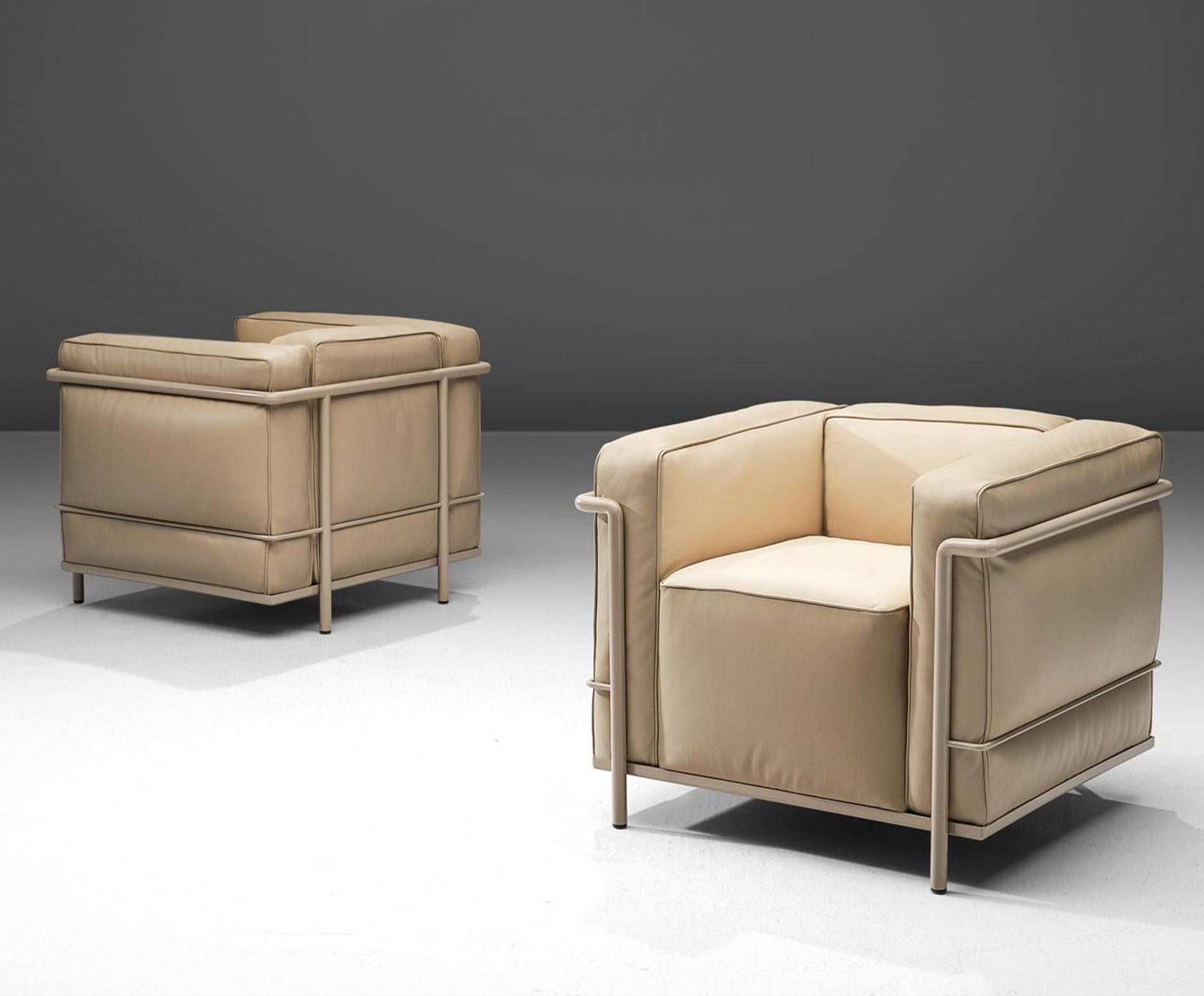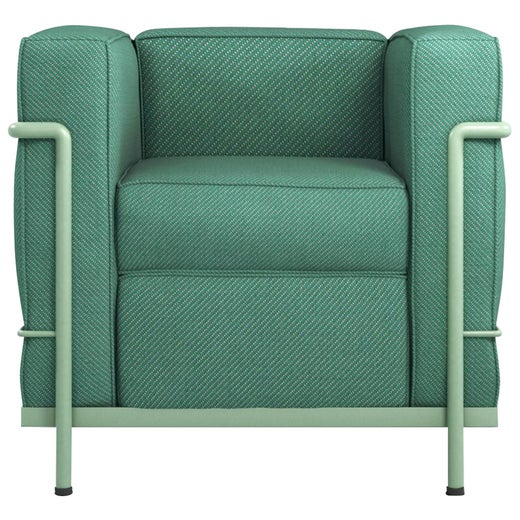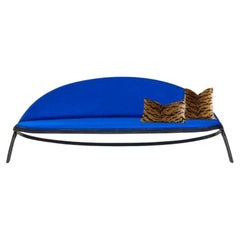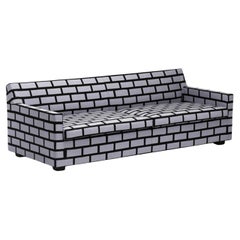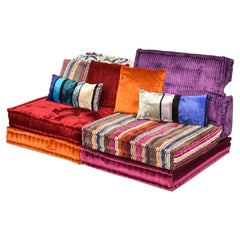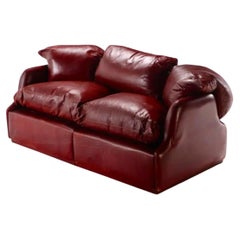Le Corbusier LC2 Three-Seat Sofa in Ivory Leather, Chrome, Cassina, Minimalism
About the Item
- Creator:Le Corbusier, Pierre Jeanneret, Charlotte Perriand Cassina (Designer),Cassina (Manufacturer),Le Corbusier (Designer)
- Design:
- Dimensions:Height: 27 in (68.58 cm)Width: 71 in (180.34 cm)Depth: 28 in (71.12 cm)Seat Height: 19 in (48.26 cm)
- Style:Mid-Century Modern (Of the Period)
- Materials and Techniques:
- Place of Origin:
- Period:
- Date of Manufacture:circa 2006
- Condition:Wear consistent with age and use. Good to fair vintage condition. Leather is in good vintage condition. Chrome shows some scuffing at the sides. Overall Minor age appropriate wear. Presents quite well.
- Seller Location:Brooklyn, NY
- Reference Number:1stDibs: LU4190312839402
LC2 Petit Confort Chair
Does anything sound more comfortable than a “cushion basket”? That’s what Charles-Édouard Jeanneret (1887–1965), a.k.a. Le Corbusier, and his collaborators, cousin Pierre Jeanneret (1896–1967) and Charlotte Perriand (1903–99), dubbed the LC2 Petit Confort chair (as well as the rest of the similarly shaped seats in the LC series), the group’s modern take on an age-old form: the club chair.
The LC2 Petit Confort chair quite literally inverts the traditional construction of a chair (or any piece of furniture, really) using an exoskeleton of chromed tubular steel instead of hiding the construction inside, prioritizing an emphasis on function that boldly declared their modernist approach. Meanwhile, thick leather cushions make the seat exceptionally comfortable and lend it a boxy appearance that is compatible with the architecture and design of the International Style in which the group worked.
The trio conceived the cube-like seats in the LC collection in 1928 for exhibition at the 1929 Parisian art fair Salon d’Automne, and Austrian manufacturer Thonet was producing the group's designs at the time. Decades later, in 1965, when the designers’ modernist style had become widely popular, the LC2 Petit Confort chair was issued by Italian manufacturer and high-end furniture company Cassina, which continues to produce it today, along with the stylistically similar LC3 collection.
The LC2 armchair was born of a period of experimentation with tubular chrome by the Le Corbusier group — archival sketches authored by Le Corbusier and Perriand are demonstrative of a two-year collaborative process, while Le Corbusier's brief identifies the latter as having been put in charge of furniture and interiors. (Furniture designer and architect Marcel Breuer, whose Cesca chair was similarly structured, was also working with chrome.) The use of chrome in the trio’s LC lines was groundbreaking at that point, and its aesthetic aligned well with Le Corbusier’s having given the furniture the mechanical-sounding label “domestic equipment.”
Le Corbusier, Pierre Jeanneret, Charlotte Perriand Cassina
The trio of Charlotte Perriand, Le Corbusier and Pierre Jeanneret is known for its widely acclaimed and influential modernist furniture designs.
In the early 1920s, Charles-Édouard Jeanneret, the revered Swiss-French architect known professionally as Le Corbusier, entered into collaboration with his cousin, Pierre Jeanneret, who shared his grand vision for egalitarian building projects and interior design. They later recruited the pioneering young female architect Charlotte Perriand to join their venture.
Perriand's installation Bar sous le toit (“bar under the roof”), a recreation of part of her own apartment shown at the 1927 Salon d’Automne in Paris, caught Le Corbusier's attention and prompted the cousins to recruit her to work at their architecture practice. She would be tasked with designing interiors and furniture. Such status was rare for a woman at the time — in fact, when Perriand sought work at Le Corbusier’s atelier mere months before the exhibition, he famously dismissed her with a sexist remark.
The collective called their shared project l’équipement d'intérieur de l’habitation (“the interior equipment of the house”), and they designed furniture that remains celebrated today. The LC series of armchairs, lounge chairs and sofas, for example, saw the designers working with tubular chrome steel and plush foam cushions upholstered in leather. Bereft of ornament and prized for its functionality, the series is currently manufactured by Cassina. The cohort's LC4 chaise lounge was displayed at the 1929 Salon d’Automne, and the spare but sculptural seat — as well as the group’s other furnishings — influenced the likes of Willy Rizzo as well as a range of other modernist designers and furniture innovators.
Reportedly owing to political differences, the trio’s collaboration ended in 1937. Le Corbusier and Pierre continued working together, primarily in architecture.
In the early 1950s, at the invitation of Indian Prime Minister Jawaharlal Nehru, Le Corbusier and his cousin collaborated on a building project in Chandigarh, India. While the Chandigarh project is most frequently associated with Le Corbusier, he didn’t actually move to India and instead monitored progress during visits to the region. Pierre, however, was extensively involved. As the project’s first chief architect, Pierre remained onsite to oversee implementation of design and to coordinate construction of schools, government housing, shopping centers and more.
In 1940, Charlotte Perriand moved to Japan after France fell to Nazi forces. She was offered a position at the Japanese Ministry of Trade and Industry as a consultant on the country’s industrial arts. While there, Perriand adopted many Japanese artistic principles and incorporated them into her own revolutionary furniture designs. She would also closely collaborate with self-taught French furniture designer Jean Prouvé in the years that followed.
Time has shown that some of the works attributed to the Jeanneret cousins are either Perriand’s own designs or she was an uncredited contributor.
On 1stDibs, find an array of vintage Charlotte Perriand, Le Corbusier and Pierre Jeanneret furniture, including tables, storage cabinets and lighting.
You May Also Like
Mid-20th Century Italian Bauhaus Sofas
Steel, Chrome
Mid-20th Century Italian Mid-Century Modern Sofas
Chrome
20th Century Italian Bauhaus Sofas
Leather, Upholstery, Lacquer
Mid-20th Century Italian Bauhaus Sofas
Steel, Chrome
Early 2000s Italian Modern Sofas
Steel, Chrome
Vintage 1970s Italian Mid-Century Modern Sofas
Steel
Vintage 1980s Italian Modern Sofas
Steel
Early 2000s Italian Mid-Century Modern Loveseats
Chrome
20th Century Italian Bauhaus Sofas
Leather, Upholstery, Lacquer
Vintage 1970s Italian Mid-Century Modern Sofas
Chrome
More From This Seller
View AllMid-20th Century Italian Mid-Century Modern Sofas
Steel
21st Century and Contemporary British Post-Modern Sofas
Textile
21st Century and Contemporary Italian Mid-Century Modern Sectional Sofas
Silk, Velvet
Mid-20th Century Italian Mid-Century Modern Loveseats
Leather
Late 20th Century Italian Mid-Century Modern Books
Paper
Mid-20th Century American Mid-Century Modern Sectional Sofas
Brass
